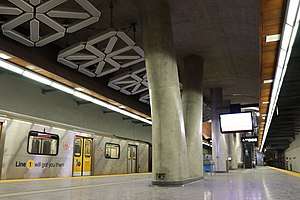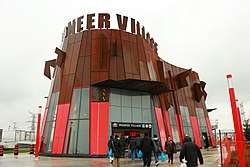Pioneer Village station
 | |||||||||||
| Location |
185 Northwest Gate, Toronto & 2800 Steeles Avenue West, Vaughan, ON Canada | ||||||||||
| Coordinates | 43°46′37″N 79°30′34″W / 43.77694°N 79.50944°WCoordinates: 43°46′37″N 79°30′34″W / 43.77694°N 79.50944°W | ||||||||||
| Platforms | Centre platform | ||||||||||
| Tracks | 2 | ||||||||||
| Connections |
| ||||||||||
| Construction | |||||||||||
| Structure type | Underground | ||||||||||
| Parking | 1850 spaces | ||||||||||
| Disabled access | Yes | ||||||||||
| Architect | Spadina Group Associates | ||||||||||
| Architectural style | Postmodern architecture | ||||||||||
| History | |||||||||||
| Opened | December 17, 2017[1] | ||||||||||
| Services | |||||||||||
| |||||||||||
Pioneer Village is a subway station on the Line 1 Yonge–University of the Toronto subway. It is located under the intersection of Northwest Gate and Steeles Avenue, at the city boundaries of Toronto and Vaughan, Ontario, Canada. A Toronto Transit Commission (TTC) bus terminal is connected to the southern portion of the station, and there is a regional bus terminal, the Pioneer Village Terminal, for connecting to York Region Transit (YRT) buses on the north side of Steeles Avenue. Pioneer Village, Highway 407 station and Vaughan Metropolitan Centre station are the first subway stations of the Toronto subway network located fully or partially outside of the present-day boundaries of Toronto.
Station name
The station was originally expected to be named Steeles West, but was renamed Black Creek Pioneer Village on September 28, 2012, after the heritage museum of the same name.[2] On July 24, 2013, the unbuilt station was renamed once more, shortening it to Pioneer Village.[3]
Description

The station lies on a northwest-southeast axis, with the line approaching the station from York University station northwestward, directly under the university's main buildings. The northern portion of the station lies in the City of Vaughan (York Region) and the southern portion in the City of Toronto. There are three station entrances, two being structures that are situated on both the north and south sides of Steeles Avenue. One of two south entrances (in Toronto) connects to the fare-paid TTC bus terminal.[4][5] with 12 bays.[6] The other is incorporated into the bus terminal itself and is accessed via a signalized crosswalk across the bus driveways from the university's sports facilities. The third—the north entrance in Vaughan—is adjacent to the York Region Transit bus terminal as well as an on-street passenger pick-up and drop-off area. A large commuter lot with a 1,881-vehicle capacity is situated in the hydro corridor to the north of the YRT terminal. Unusually, both street entrances lead to separate mezzanine levels, despite both serving as primary points of access (although many stations have secondary automatic entrances), and it is necessary for non-subway riders transferring between TTC and YRT buses to go down to and walk the length of the platform to connect between the two bus terminals.
_486a-18.jpg)
The station has three levels: the entrances at street level, the two mezzanines just below them, and the train platform at bottom. Enough space has been left between the surface and the platform to allow for the construction of an underground station for a future light rail transit line.[4]
The Spadina Group Associates designed the station, which features entrance structures on the southeast and northwest sides at a street intersection. The layout makes the entrances mirror each other, giving an overall symmetrical effect. The southwest corner of the intersection also includes an oculus for a light cone above the platform. Both entrance structures have cool roofs and green roofs.[4][5] To the south of the station, there is a crossover to short turn trains.
Artwork
_347a-18.jpg)
Artists Tim Edler and Jan Edler of Berlin-based Realities-United provided interactive artwork, titled LightSpell, consisting of a row of 40 light fixtures suspended from the ceiling over the platform. These units can display text as well as illuminate the platform.[7][8] The intent of the artists was that waiting passengers would key in text (maximum of 8 characters) using several touch screens for display on the lighting units. Other waiting passengers could change the text. However, when the TYSSE opened, the TTC decided not to activate this feature, despite previously agreeing to do so as shown by the installation of the commissioned piece, because of the potential for displaying offensive messages. Given that the 2009 revision of the TTC By-law No. 1 explicitly prohibits the use of such language, a question remains of how that by-law would apply to an artwork as it is not itself communicating "profane, insulting or obscene language or gestures".[9] The TTC is negotiating a compromise solution with the artists, raising questions of how a compromise of this nature undermines the fundamentals of the artwork.[10][11] The cost of the artwork was $500,000.[12]
Fare collection
As with all stations from Wilson north to Vaughan Metropolitan Centre, legacy TTC fare media (tokens, tickets and Metropasses) are accepted at this station pending elimination, but they cannot be purchased by passengers, who otherwise need to pay exact change for cash fares. Presto cards can be purchased and loaded with funds for single rides or with TTC monthly Metropasses for unlimited travel, using various automated machines at the station.[13]
Nearby landmarks
The major buildings of York University's main Keele Campus lie to the southeast of location. Canlan Ice Sports and Aviva Centre are found to the southwest, the Toronto Track and Field Centre to the east and York Lions Stadium to the immediate south. The station's namesake, Black Creek Pioneer Village, lies less than one kilometre to the southwest.
History
On November 27, 2009, the official ground breaking ceremony was held for the TYSSE, and tunneling began in June 2011. The project was expected to be completed by the autumn of 2016,[14] On September 6, 2017, the TTC announced that the line would begin service on December 17, 2017.
The station was originally planned to be a temporary terminus for the western arm of Line 1 Yonge–University, which would later be extended to Vaughan Metropolitan Centre. However, the entire extension opened simultaneously.
Surface connections
The following routes serve this station.[15]
| Route | Name | Additional Information |
|---|---|---|
| 35A | Jane | Southbound to Jane station |
| 35B | Southbound to Jane station via Hullmar Drive (Rush hour service) | |
| 41A | Keele | Southbound to Keele station |
| 60A/B/D | Steeles West | Eastbound to Finch station |
| 60B | Westbound to Martin Grove Road | |
| 60D | Westbound to Highway 27 | |
| 84D | Sheppard West | Eastbound to Sheppard–Yonge station (Rush hour service) |
| 106 | Sentinel | Southbound to Sheppard West station |
| 107 | St. Regis | Southbound to Sheppard West station |
| 108A | Driftwood | Southbound to Sheppard West station via Grandravine Drive |
| 108B | Southbound to Sheppard West station via Arleta Avenue | |
| 935 | Jane Express | Southbound to Jane station |
| 960 | Steeles West Express | Eastbound to Finch station (Rush hour service) |
| 335 | Jane | Northbound to York University, southbound to Jane station |
| 353 | Steeles | Westbound to York University, eastbound to Staines |
Pioneer Village Terminal
Pioneer Village Terminal | |
|---|---|
| Location |
2800 Steeles Avenue West, Vaughan, Ontario Canada |
| Coordinates | 43°46′41″N 79°30′43″W / 43.77806°N 79.51194°W |
| Owned by | Regional Municipality of York |
| Operated by | York Region Transit |
| Bus routes |
|
| Bus stands | 5 |
| Connections |
|
| Construction | |
| Disabled access | Yes |
| History | |
| Opened | December 17, 2017 |
A York Region Transit bus terminal[16] is located outside the station's fare-paid area on the north side of Steeles Avenue on the west side of Northwest Gate.[17][18] It lies adjacent to the commuter parking lot and has an outdoor walkway linking it with the station. There are no free transfers between these routes and the subway.
The following YRT routes serve the terminal:
| Route | Name | Additional Information |
|---|---|---|
| 3 | Thornhill | Eastbound to Steeles Avenue and Don Mills Road via Promenade Terminal |
| 20 | Jane | Northbound to Teston Road via Highway 407 & Vaughan Metro Centre stations, and Vaughan Mills Terminal |
| 96 | Keele–Yonge | Northbound to Newmarket Bus Terminal via King Road (Weekday service) |
| 107 | Keele | Northbound to Teston Road |
| 107B | Northbound to Rutherford GO Station (Weekday service) | |
| 165 | Weston | Northbound to Major Mackenzie Drive |
| 165F | Northbound to Canada Drive (Rush hour service) |
References
- ↑ Beattie, Samantha; Spurr, Ben (December 16, 2017). "After delays, cost overruns, and tragedy, a subway to Vaughan is complete". Toronto Star. Retrieved December 17, 2017.
- ↑ Kalinowski, Tess (September 28, 2012). "TTC names new subway station for Black Creek Pioneer Village". Toronto Star. Retrieved September 28, 2012.
- ↑ TTC renames new subway stop Pioneer Village station, Toronto Sun, July 24, 2013
- 1 2 3 "Toronto-York Spadina Subway Extension Project Steeles West Station : Approval Of Conceptual Design" (PDF). www3.ttc.ca. Toronto Transit Commission. Retrieved November 11, 2017.
- 1 2 "Pioneer Village Station". Toronto Transit Commission. Retrieved November 25, 2017.
- ↑ Moore, Oliver; Gray, Jeff (December 14, 2017). "Next stop, Vaughan: Inside the Toronto subway's big move beyond the city limits". The Globe and Mail. Retrieved December 15, 2017.
- ↑ Dixon, Guy (September 29, 2017). "A subway station worth lingering in". The Globe and Mail. Retrieved October 3, 2017.
- ↑ "TYSSE: Pioneer Village Station". UrbanToronto. Retrieved October 4, 2017.
- ↑ "TTC By-law No. 1". www.ttc.ca. Retrieved September 2, 2018.
- ↑ GmbH, BauNetz Media (January 29, 2018). "Dunkelheit statt freier Meinung - Zensierte Lichtinstallation von realities:united in Toronto". baunetz.de. Retrieved September 2, 2018.
- ↑ "Can the Public Be Trusted to Make Public Art?". canadianart.ca. Retrieved September 2, 2018.
- ↑ Cruickshank, Ainslie (December 22, 2017). "TTC backtracks on $500,000 station art installation". Toronto Star. Retrieved December 22, 2017.
- ↑ "New Customer Service Agents at TTC stations". Toronto Transit Commission. Retrieved February 18, 2018.
- ↑ "Schedule Status Update" (PDF). Toronto-York Spadina Subway Extension Project. Toronto Transit Commission. October 24, 2012. Retrieved October 29, 2012.
- ↑ "TTC Service Changes Effective Sunday, December 17, 2017". Stevemnro.ca. October 25, 2017. Retrieved November 11, 2017.
- ↑ "Pioneer Village Terminal" (PDF). yrt.ca. Retrieved September 2, 2018.
- ↑ "Spadina Subway Transit Strategy" (PDF). 2015 Annual Service Plan. York Region Transit. 2015. p. 145. Retrieved April 16, 2016.
- ↑ "YRT/Viva Spadina Subway Transit Strategy" (PDF). Archived from the original (PDF) on September 13, 2014.
External links
| Wikimedia Commons has media related to Pioneer Village station. |
- Pioneer Village Station
- Hate speech concerns stall Toronto subway art installation on YouTube Published by CBC News on December 28, 2017
- Lightspell at realities:united